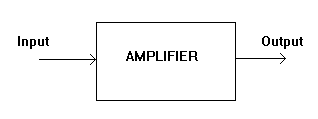|
Amplifiers are used to increase the voltage or power amplitude of signals. They have many applications. 
AUDIO VOLTAGE amplifiers boost the amplitude of signals between the frequency range 20 Hz to 20 KHz. This is the range of human hearing. They are often used as PRE-AMPLIFIERS before the main amplifier.
AUDIO POWER amplifiers provide the power necessary to drive loudspeakers. They also amplify a frequency range from 20Hz to 20 KHz.
INTERMEDIATE FREQUENCY (i.f.) amplifiers are used in radio receivers. High frequency radio signals are changed to the lower intermediate frequency by a FREQUENCY CHANGER circuit. The i.f in A.M. radios is about 455 KHz. In F.M. radios it is 10.7 MHz.
RADIO FREQUENCY amplifiers amplify a selected band of frequencies. Radio frequencies extend from about 30 KHz up to several thousand MHz.
The band of frequencies is selected by a BAND PASS FILTER or a TUNING circuit.
WIDE BAND amplifiers are designed to amplify a very wide band of frequencies, say from a few Hertz up to several hundred MHz.
VIDEO amplifiers are used in television cameras, receivers, vcr's etc. The bandwidth extends from DC up to about 6MHz.
DIRECTLY COUPLED amplifiers have no coupling capacitors between stages so that they are able to amplify DC signals.
DIFFERENTIAL amplifiers have two inputs and amplify the DIFFERENCE between the two input voltages.
If both inputs are the same then there is no output from the amplifier.
If there is an interfering signal then it will be picked up by both inputs and will not be amplified.
OPAMPS are commonly used as differential amplifiers. |